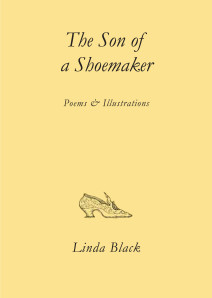Linda Black, who has already planted her feet firmly in the prose poem and experimental writing camp having previously delivered two books of prose poems (published by Shearsman) delivers a pamphlet designed to push the boundaries of both narrative and poetry. The Son of a Shoemaker is a collection of prose poems (or found prose poems) collaged from the 1940’s book of the same name by Constance Buel Burnett. Burnett’s book is a semi-fictional biography of the early life of Hans Christian Anderson – the book was aimed at school children.
You might expect that Black’s poems would follow some kind of narrative along similar lines to the original book but it doesn’t seem to. Without having a copy of the original text it is impossible to tell whether Black has jumped around within the text or taken phrases in the order they crop up in the book, but this doesn’t really matter. What matters is whether these poems stand up as poems and as a collection of poems, and I believe that they do. Black has chosen to focus on the relationships between Anderson and those around him as well as Anderson’s relationship with fairy tale and the written word. There are also echoes of Black’s own relationship with poetry within the text. This is an intriguing collection. Fantastical and domestic scenes jostle against each other in the same poems, and often in the same lines. The world that Black’s Anderson inhabits is a dark and confusing place inhabited by scary school mistresses and other odd characters. It is not a comfortable place to be – he seems at odds with the world around him, the people that populate it, his own body, and even his own sense of self and reality.
Black has an eye for a good phrase and the titles of the poems are great and at first glance might lead one to expect more of a linear or conventional narrative – e.g. He had led many lunatics to the Chief Director’s Office. Thank fully this is not usually the case and while the poems do allude in some way to their titles they do not always make sense in a conventional way. There are one or two exceptions – Before he could feel frightened for instance is much more straightforward than many of the other poems and follows a slightly more conventional narrative style. These poem are peopled with beautiful phrases and interesting syntax.
Phantasmagoria picked him a nosegay. Rang easily and
often his heart coiled against her braids: plunged him into
that world less and less actual.
(The Cord of ecstasy is a fragile one)
They often evoke a feeling, a sense of time and place rather than telling a story or spelling something out to the reader. Even at their most elusive there is something ethereal and beautiful about them. The phrases sing in a marvellous language of their own:
Great raw bone hands cut with magic. Fragile lace.
Paper-thin thighs. Mannersisms misfit and dilapidated.
gestures slipped and fell.
(His head swam from other causes than mere suffocation)
I did, however, find myself wondering if the idea behind the poems merited a whole pamphlet. Personally I would have been happy to see the strongest poems as a sequence in a larger collection. As a pamphlet I found them hard going and had to keep leaving them alone for a while and coming back to them. The text is broken up by Black’s pen and ink drawings – the drawings have a light fairy tale quality which while it suits the mood of the subject matter, for me didn’t quite live up to the cleverly playful but highly constructed nature of the poems – even though Black is clearly an accomplished artist. This was an interesting read – I shall be seeking out more of Black’s work.
Buy your copy of The Son of a Shoemaker by Linda Black (Hearing Eye) here

